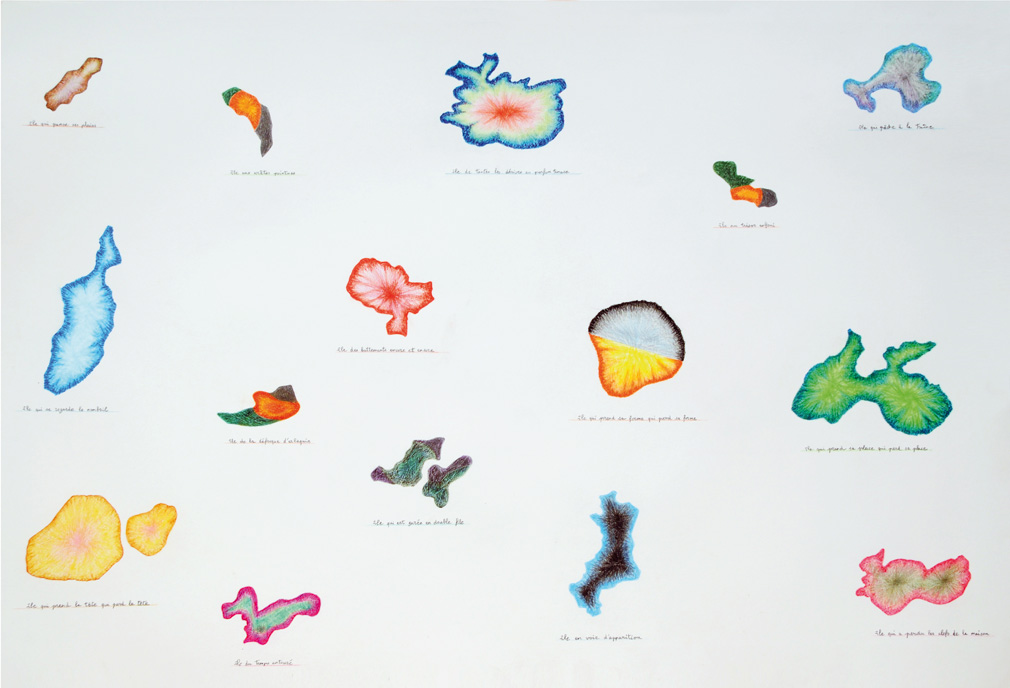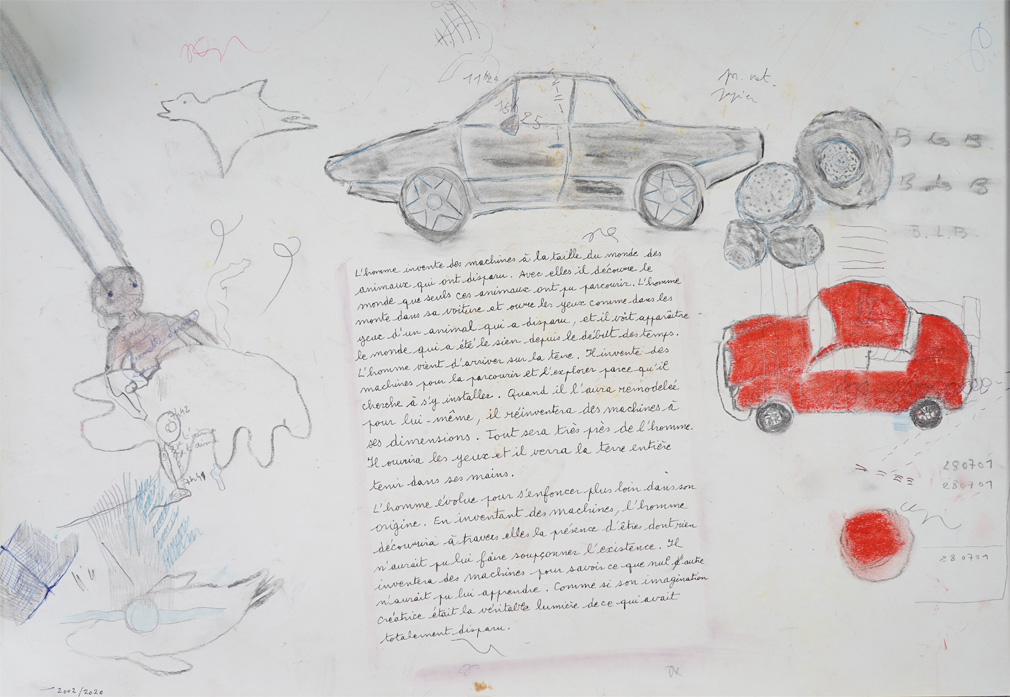Comme un fleuve qui déborde
The exhibition
25 artists for an overflow of art
Starting from the magazine Le Bout des Bordes - initiated in 1975 by Jean-Luc Parant, a kind of artist's logbook -, this artistic ensemble has rapidly expanded, constantly calling for new volumes, new reissues, and now escapes from the paper recently printed by Acte Sud to be exhibited on the walls of the space Topographie de l'art where it finds an ideal extension. In addition to Jean-Luc Parant, twenty-four artists were chosen among the 280 or so that could be found in the magazine, "twenty-four artists like the twenty-four hours of a day and a night," explains Kristell Loquet, "that is to say, a complete turn of the earth on itself in front of the sun, in the great movement of the stars and planets."
In Topography of Art, we ask ourselves if art can be seen through the prism of geographical science in order to be better apprehended, analyzed, and understood. Can art be contained in a place where it would be presented without any overtaking? Can it be enclosed in a geographical map that would control its strength as the name "topography of art" suggests? It is almost with the intention of contradicting this idea that the curators Kristell Loquet, Clara Dijan and Nicolas Leto have mounted the exhibition Comme un fleuve qui déborde. Together they draw the comparison of contemporary art as an unstable element that mixes, crosses, overlaps, and overflows. The key is in this last word: the idea of overflowing, of not being able to be held back and controlled, whether by the frame of a work or by the cover of a magazine. The drawing does not fit into the boxes and the words do not stop at the line: everything is a tidal wave and cataclysm, overflow and artistic groundswell.
The overflow is spun through a metaphor of Jean-Luc Parant: "Give me a text or an image of you when you are the most alive, when you overflow of yourself on your sheet of paper, on the canvas, on your screen, on your wall ... when you make a wish, when your heart pours out, when you are happy to be there, and I will hang your work in my precious pantheon. Art is presented as an overflow of oneself, which needs other supports than one's own being to subsist. The painting "gushes" onto André Cervera's paper in this artistic storm, unable to be contained within the artist's interiority, and which ultimately represents life in its most turbulent form.
This flow of art is also characterized by continuity, the flow that flows without stopping as Pierre Tilman explains when talking about his series of floating islands, started in 1977, then "reactivated" in 2012, and again in 2020, and again at Topography of Art. Inspiration drifts and takes to the sea, sinks and flows, but always returns in this discontinuous river that "pours out to give birth to the living world". Poetry is everywhere in Jean-Luc Parant's review, mixing figures of style and works of plastic art, writing and painting. The overflow is on all sides, and has not finished stopping to exceed the borders.
Lolita Fragneau
Starting from the magazine Le Bout des Bordes - initiated in 1975 by Jean-Luc Parant, a kind of artist's logbook -, this artistic ensemble has rapidly expanded, constantly calling for new volumes, new reissues, and now escapes from the paper recently printed by Acte Sud to be exhibited on the walls of the space Topographie de l'art where it finds an ideal extension. In addition to Jean-Luc Parant, twenty-four artists were chosen among the 280 or so that could be found in the magazine, "twenty-four artists like the twenty-four hours of a day and a night," explains Kristell Loquet, "that is to say, a complete turn of the earth on itself in front of the sun, in the great movement of the stars and planets."
In Topography of Art, we ask ourselves if art can be seen through the prism of geographical science in order to be better apprehended, analyzed, and understood. Can art be contained in a place where it would be presented without any overtaking? Can it be enclosed in a geographical map that would control its strength as the name "topography of art" suggests? It is almost with the intention of contradicting this idea that the curators Kristell Loquet, Clara Dijan and Nicolas Leto have mounted the exhibition Comme un fleuve qui déborde. Together they draw the comparison of contemporary art as an unstable element that mixes, crosses, overlaps, and overflows. The key is in this last word: the idea of overflowing, of not being able to be held back and controlled, whether by the frame of a work or by the cover of a magazine. The drawing does not fit into the boxes and the words do not stop at the line: everything is a tidal wave and cataclysm, overflow and artistic groundswell.
The overflow is spun through a metaphor of Jean-Luc Parant: "Give me a text or an image of you when you are the most alive, when you overflow of yourself on your sheet of paper, on the canvas, on your screen, on your wall ... when you make a wish, when your heart pours out, when you are happy to be there, and I will hang your work in my precious pantheon. Art is presented as an overflow of oneself, which needs other supports than one's own being to subsist. The painting "gushes" onto André Cervera's paper in this artistic storm, unable to be contained within the artist's interiority, and which ultimately represents life in its most turbulent form.
This flow of art is also characterized by continuity, the flow that flows without stopping as Pierre Tilman explains when talking about his series of floating islands, started in 1977, then "reactivated" in 2012, and again in 2020, and again at Topography of Art. Inspiration drifts and takes to the sea, sinks and flows, but always returns in this discontinuous river that "pours out to give birth to the living world". Poetry is everywhere in Jean-Luc Parant's review, mixing figures of style and works of plastic art, writing and painting. The overflow is on all sides, and has not finished stopping to exceed the borders.
Lolita Fragneau
When
20/05/2022 - 16/07/2022




